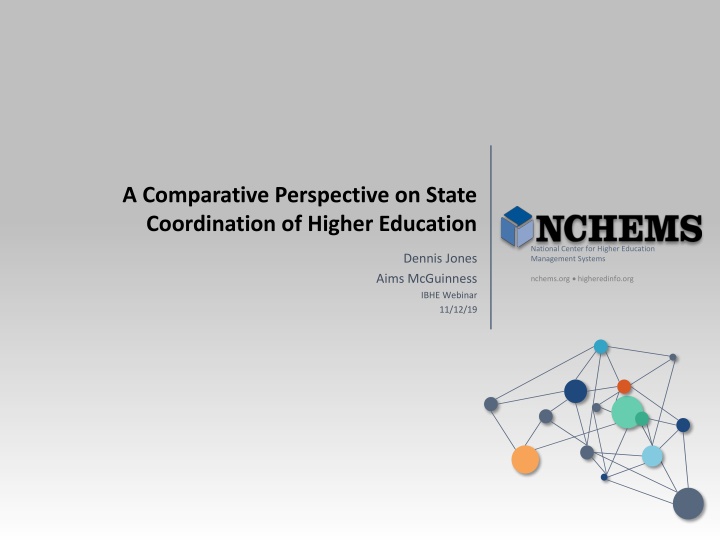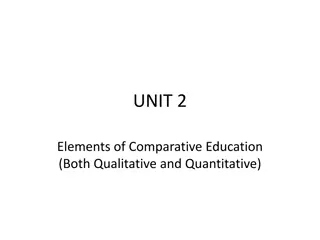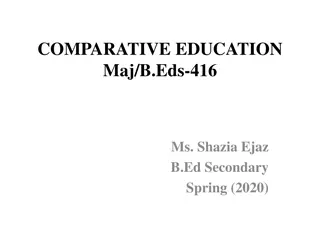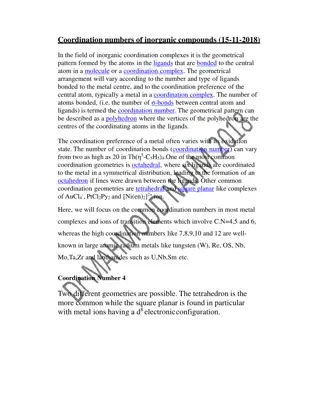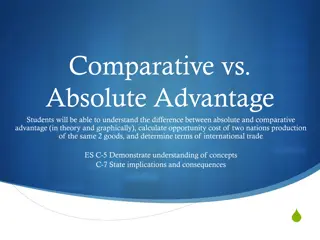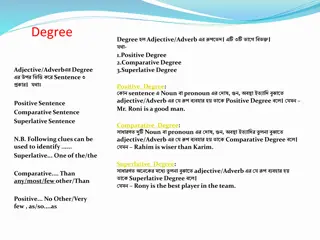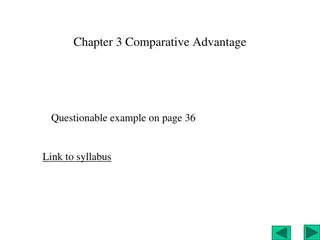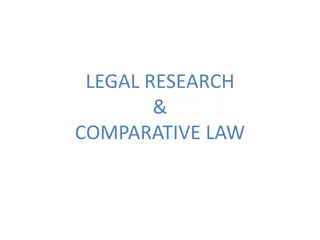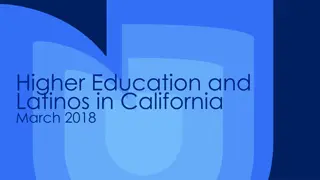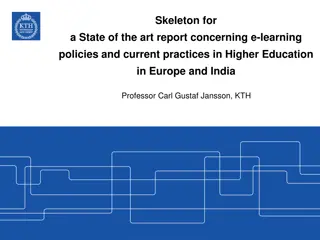Comparative Analysis of State Coordination in Higher Education Systems
This comparative perspective explores the state coordination of higher education in various states, highlighting the differences in governance structures, authority of boards, and levels of coordination. It cautions against replicating models due to unique state factors and emphasizes the distinct roles of coordinating boards versus governing boards. Examples from Illinois, Kentucky, Virginia, Oregon, Indiana, Washington, Alabama, Colorado, South Carolina, and Tennessee illustrate the varied approaches to managing higher education systems.
Download Presentation

Please find below an Image/Link to download the presentation.
The content on the website is provided AS IS for your information and personal use only. It may not be sold, licensed, or shared on other websites without obtaining consent from the author.If you encounter any issues during the download, it is possible that the publisher has removed the file from their server.
You are allowed to download the files provided on this website for personal or commercial use, subject to the condition that they are used lawfully. All files are the property of their respective owners.
The content on the website is provided AS IS for your information and personal use only. It may not be sold, licensed, or shared on other websites without obtaining consent from the author.
E N D
Presentation Transcript
A Comparative Perspective on State Coordination of Higher Education National Center for Higher Education Management Systems Dennis Jones Aims McGuinness IBHE Webinar nchems.org higheredinfo.org 11/12/19
Coordination in Comparative Perspective Illinois is one of 21 states that has a statewide coordinating agency Only about 12 of these have authority roughly comparable to IBHE More than half the states organize their public higher education institutions under two or more system or institutional governing boards. 2
Cautions About Comparisons: No Ideal Model Not a good idea: copying another state s structure Each state s structure evolved in response to unique state issues/conditions Modes of provision (public vs. Private) History/culture Role of government Governor State legislature Geo-political balance, regional disparities Budgeting and finance policy and process
Coordination Versus Governance Authority and functions of coordinating boards are distinctly different from governing boards of institutions and system Coordinating boards Focus on statewide policy leadership, not on governing/managing systems or individual institutions Do not govern institutions (e.g., make decisions regarding appointment of system and institutional presidents or faculty and other personnel issues) System and institutional governing boards have authority to develop and implement policy 4
Kentucky, Virginia, Oregon, Indiana, and Washington State State Level Coordinating Board State Level Governing Board Institution-Level Governing Boards for Each University Several Universities Community Colleges Explanation: Each public university has a governing board. State board for community colleges either governs the colleges or coordinates locally governed community colleges. Coordinating boards plan and coordinate the whole system. Note: Kentucky and Virginia community college boards are a statewide governing boards whereas the Washington State community college board is a coordinating board for locally governed colleges. 5
Alabama, Colorado, South Carolina, and Tennessee State Level Coordinating Board State Level Governing Board One or More Multi- Campus Governing Boards Institution-level Governing Boards for Several Universities Two or More Universities Several Universities Community or Tech Colleges Explanation: Complex system of institutional governance including some multi-campus systems and some institutions with individual governing boards. State-Level board is responsible for coordinating the whole system. 6
North Carolina, Georgia & Wisconsin State Level Governing Board State Level Governing Board System, Research, & Regional Universities Technical Colleges Explanation: Two separate boards govern public institutions, one board for the research university and other university campuses as well as 3-year (primarily transfer colleges, and the rother board for technical colleges. 7
Typical Traditional Functions of Coordinating Boards Statewide strategic/long-range planning Policy analysis and problem resolution Academic program review/approval Finance policy Budget analysis and recommendations (operating and capital) Developing, recommending and implementing funding formulas Develop and maintain data/information systems Accountability reporting 8
Other Functions Program/project administration Licensure/authorization of institutions Also, coordinating boards in some states administer state student financial programs (e.g., Tennessee and Washington state) 9
The Implementation Tools Strategies for Achieving Goal Attainment Foster Resolution of Cross-cutting issues Planning and Leadership Finance Regulation Accountability Alignment Goal 1 Consistency Goal 2 Goal 3 10
Effective Coordinating Boards Focus on core policy functions (planning/policy leadership, budget/resource allocation, evaluation and accountability) Align and integrate policy functions to advance the goals of the state s strategic plan/public agenda Continued 11
Effective Boards (Continued) Have the credibility and capacity to engage the state s political, civic and private- sector leaders to address the major challenges facing the state and higher education Focus on WHAT, not HOW Exhibit balance in processes and decision-making Non-partisan Serves both legislative and executive branches Between the state and institutions Among all sectors and providers Across all regions of the state Across all dimensions of mission (community college services to research and graduate education)
Sustained Public Policy Leadership Must Include A broad-based public entity with a clear charge to increase the state s educational attainment and prepare citizens for the workforce. Strength to counter inappropriate political, partisan, institutional, or parochial influences. Capacity and responsibility for articulating and monitoring state performance objectives for higher education that are supported by the key leaders in the state; objectives should be specific and measurable. Engagement of civic, business, and public school leaders beyond state government and higher education leaders. Recognition of distinctions between statewide policy and the public entities and policies needed to accomplish it and institutional governance. Information gathering and analytical capacity to inform the choice of state goals/priorities and to interpret and evaluate statewide and institutional performance in relation to these goals. Capacity to bring coherence and coordination in key policy areas, such as the relationship between institutional appropriations, tuition, and financial aid. Capacity to influence the direction of state resources to ensure accomplishment of these priorities.
Formal Versus Informal Authority Coordinating boards gain their most significant influence/power through advice/recommendations to the governor and state legislature Coordinating boards generally do not have authority to implement policy, except for specific programs Influence depends less on formal authority than on Reputation for objectivity, fairness, and timeliness of analysis and advice to legislative and executive branches Capacity to gain trust and respect (but not always agreement) of the state s institutional/system leaders who recognize that effective coordination is essential to address state policy issues that cannot be addressed only through voluntary coordination among institutions/systems 14
Historical Development of Statewide Coordination Most Established in mid-20th Century Illinois was First State to Establish a Coordinating Board Lyman Glenny, Autonomy of Public Colleges. New York: McGraw-Hill, 1959 Context Period of Massive Expansion State Appropriations were Principal Funding Source Original Purpose: Rationalize the development of higher education systems Provide advice to the Governor and State Legislature Curb Unnecessary Duplication Counter Turf Battles Among Institutions and Regions Original coordinating boards tended to focus: On Internal Higher Education Issues and Not on State Priorities . Strategic Plans Began with Institutions, not the State and its population and economy Public institutions (although private independent HE was occasionally at the table)
Historical Development From late 1970s through early 1990s, the authority of many coordinating boards was increased to include Review, approve and, in some cases, discontinue academic programs Implement initiatives designed to improve institutional productivity and performance (e.g., The Illinois PQP program) A more aggressive stance on accountability for student outcomes In the late 1990s, coordinating boards shifted emphasis from coordinating institutions to leading a public agenda linking higher education to the future of the state
Historical Development The current context is dramatically different from that of 20 years ago From dramatic growth to declining high school graduates and more diverse student populations State appropriations are no long the largest and most stable funding source. Tuition and fee revenue is now the most important revenue source Turnover in state leadership Disinvestment in state agencies As a result, all but a few coordinating boards have drifted into a primarily regulatory role. Most are no longer seen as the venue for addressing the state s major higher education challenges 17
